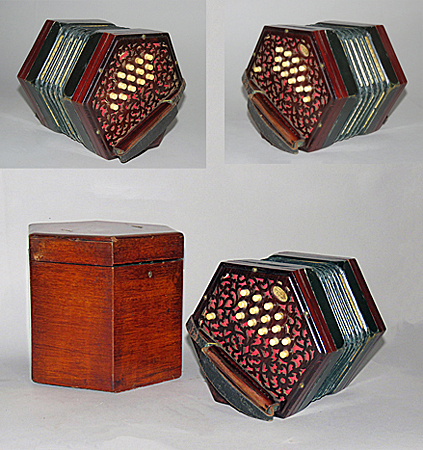
Owner: HWMC
Catalog#: CL-AEFR-01
Free Reeds
Lachenal & Co 'Button Concertina'
London, England
Lachenal & Co
Wood, bone, metal, paper
ca. 1880s
Height: 6.5 in, Width: 7 in, Depth: 5.5 in
Wind Instruments – Free Reeds
Label: “Lachenal & Co / Patent Concertina / Manufacturers / London.”
A new group of free-reed musical instruments began to evolve in Europe at the beginning of the 19th century. These instruments were possibly influenced by the introduction of the Chinese free-reed mouth organ called a sheng. In Germany the mouth organ was developed around 1825. In 1829, Vienna patented an accordion, and in England, around 1829-1830, Charles Wheatstone invented the concertina.
The concertina is a hexagon shaped hand-held bellows-driven free reed instrument, with buttons on each side. It has largely remained a relatively trivial ‘folk’ instrument throughout its history. Nevertheless, there are a few sonatas, concertos and chamber works involving the concertina, by such composers as Tchaikovsky, Macfarren, Benedict, Percy Grainger, Charles Ives, Molique, Regondi and Silas. By the early years of the twentieth century, the concertina became a popular instrument of the working people in England’s northern mill towns and found a niche in the instrumentation of the Salvation Army band. However, after the 1920’s its popularity declined.
This English Victorian Lachenal & Co. 29 bone button (15 keys to one side, 14 to the other) concertina is a single voice, called uni-sonoric, with wooden fretted end plates. It is fully chromatic with steel reeds fixed by screws to separate brass plates fitted into a wooden board. It came in its original mahogany case. The label reads: “Lachenal & Co / Patent Concertina / Manufacturers / London.” Louis Lachenal was the tool maker and later manager at Wheatstone. Between 1848 -1850, he left Wheatstone and set up his own business in making concertinas.
